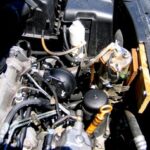I am getting items together to begin vandwelling within the next year. Vandwelling is converting a cargo or passenger van into a campervan and living in it. It is essentially creating a small RV out of a van.
I know I will have a solar power system to charge a battery bank. I will have at least four six-volt batteries wired to create 12 volts and 400 ampere-hours. To charge the batteries using the sun, I need to park outside the shade. Unfortunately, there are days where I need to seek shade, or that may just be the only spot available.
The van’s AC unit will draw power whether the batteries are being charged or not. In cold weather, the van’s insulation will help keep the inside warmer. A heater will draw power from the bank.
Originally, I thought I would carry a propane generator. What if I were not near a propane store and needed fuel? Suppose this happened at night, or during a storm?
A 2,000-watt generator weighs approximately 90 lbs, not including the weight of the tanks.
I found a better solution. I like to ride bicycles, and am an avid bicycle commuter. Why not put that to use?
I found bicycle generator kits on Amazon for different prices. You will need a few extra parts to make this work. I also found several videos on Utube that explain how to put different items together so you get a good look at building a system.
There are reasons to have a bicycle generator:
- · You can power a battery bank from inside the house during a disaster if the solar panels are damaged.
- · If fuel is not available for a generator, you have a ready source of power- you.
- · Let the kids ride and show them how this is helping to power the TV, computer, refrigerator and lights. Depending on the size of the battery bank, you can heat or cool a room as well.
- · You can power the battery bank while a storm is in progress. Just make sure your electrical wiring to the grid is disconnected while you do this. A power surge will not fry your bank or the person on the bike. I know that’s remote, but why take chances?
- · It weighs far less than a fuel-powered generator.
- · It’s easier to fix or replace parts as necessary.
You will need:
- · A bicycle generator kit. You may need to buy additional parts.
- · A 12 vdc regulator to prevent damage to the batteries while charging.
- · A drive belt if not included in the kit
- · A 15A Blocking Rectifier Diode- 15 Amps
- · Electrician’s wire cutting and crimp tool. These are available at any DIY store
- · A bicycle. Mountain bikes, road bikes or other bicycles with multi-gears. Exercise bicycles are not really good for this.
- · A spare rear wheel and sprocket set.
- · Electrical wire connectors. These are available at DIY stores, Radio Shack and online.
- · Various general tools as needed such as screwdrivers and so forth.
Step One:
Obtain all your parts. Many people have built their own stands, generator mounting plates and purchased generators to build their own “kit.”
The stand will hold the rear wheel off the ground. The front wheel rests on the ground.
The rear tire can be removed from the wheel every time you use the generator, or a spare wheel with a sprocket set can be used. Since removing the tire repeatedly causes stress to the sidewalls, I’ll use a spare wheel. If anything happens to my main wheel, I’ll have a spare.
Step Two:
Put the stand together and attach the mounting plate for the generator. The pulley wheel for the generator should be in exact alignment with the wheel. The drive belt fits around the generator’s drive shaft or pulley attachment and around the wheel. It should be snug but not tight. If it is loose, it will slip and not work.
Step Three:
Attach connectors to the blocking diode. A Utube video is extremely good at showing how.
Attach the blocking diode to the generator wires. Be sure to follow the directions for the electrical flow. It works similar to a backup water flow device. The electricity can only flow one way. This allows power to flow from the generator to the battery, not the other way around.
Step Four:
Attach the 12 vdc charge regulator to the charge controller. The charge controller detects when the batteries are full. The device will stop incoming electrical current and shunt the excess power to something else. This prevents excess wear and tear on the batteries. In the case of lead-acid batteries, it prevents them from boiling over or blowing up. Literally.
Step Five:
Set up the stand, bicycle and the gear. Attach the wiring and mount the bicycle. Start pedaling the bicycle.
Using the rear wheel allows the cyclist to change gears so you produce more power. The charge regulator will not allow more power to be delivered to the batteries than they can safely handle.
Enjoy the power from your battery bank.
By purchasing a commercial kit and items, the initial cost may prove higher than a home-built system. If you are not an electrician, and I am not either, this is probably the safest option. It may also be the lightest option for traveling. Most of the stands should be able to fold for easy storage.
There are upsides to this:
- · I can stow the system easily.
- · I can use it indoors safely- no fumes
- · I do not need fuel except for food, treats and so forth.
- · I can use my main motor, aka my bicycle, as transportation.
- · The bicycle can travel attached to the back of the van.
- · I can use it no matter which way the wind is blowing- this is important when dealing with fuel-powered generators.
It’s green, it’s available and it’s easy to use. Everyone in the family can hop on and help charge the emergency, camping or RV battery bank.
Source: The author of this article has over 40 years of experience in diverse forms of DIY, home improvement and repair, crafting, designing, and building furniture, outdoor projects, RV’ing and more.




